Read about the four garter snake species of Nebraska.
Enlarge
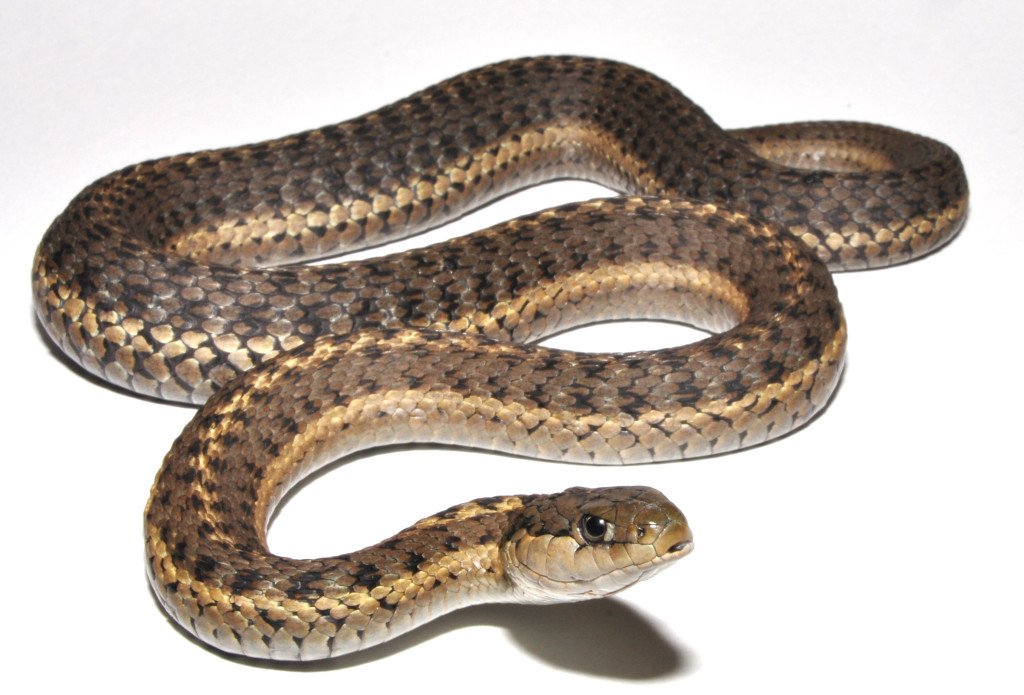
Photo by Daniel D. Fogell
By Monica Macoubrie, Wildlife Education Specialist
Most people don’t think about snakes in November, but with the near record high temperatures this year, some snakes are still slinking through the grasses or moving through our backyards in certain areas of Nebraska.
One common inhabitant that you may still see lurking about your yard, soaking up the last warm rays of the fall, is the garter snake. No, not “garden snake” or “gardner snake” — garter snake is its true name.
While these snakes might startle you as you’re mowing your lawns or picking tomatoes in the garden, these non-venomous snakes are fascinating. Let’s take a look at the garter snake species in Nebraska.
Garter Snake Identification
Nebraska is home to four species of garter snakes: the terrestrial garter snake, the western ribbonsnake, the plains garter snake and the common garter snake.
Garter snakes are known to have contrasting, colored lines running lengthwise down the entire body: one running down the middle of the back and one on each side. The position of the lines differs with each species and is one of the key identification features in telling them apart.
Commonly, the lines are cream, yellow or orange, but some can be dark or bright red. Garter snakes have even been found with white and bluish colorations as well. A good rule of thumb in Nebraska: If a snake has lines running down its body length mid-center and on each side, it is one of our garter snakes.
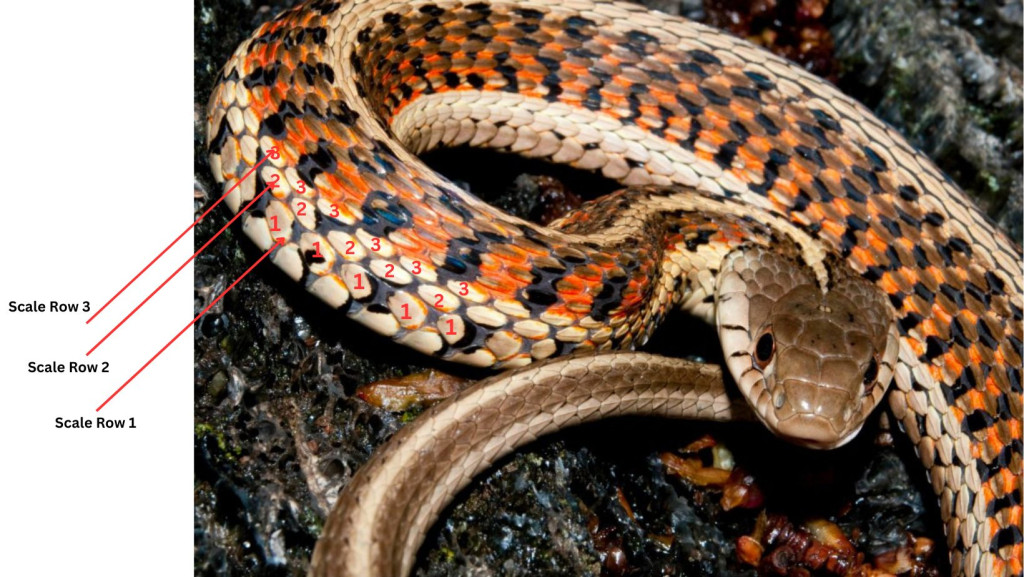
Terrestrial Garter Snake (Thamnophis elegans)
The terrestrial garter snake is presumably the rarest. This species’ range barely enters Nebraska from the west and is only found around the Pine Ridge region of Sioux and Dawes counties in the northwestern part of the panhandle. The terrestrial garter snake is most often brown, gray or bluish green with keeled, or rough-feeling, scales. There is a light colored mid-dorsal stripe that is overlain with several rows of dark spots that extend the length of the back and sides. If you can look closely, the dark spots on the middle of the back encroach on the mid-dorsal stripe, giving them a zig-zagged look. The light lateral stripes are restricted to scale rows 2 and 3.
These garter snakes are relatively small, only reaching around 20-30 inches in length. In the western United States, this is a wide-ranging species with many different local variations in color and pattern that may not conform to the above descriptions, but in Nebraska, this description should be consistent.
The terrestrial garter snake is generally found along streams and ponds in arid regions of the United States. In our Pine Ridge, they are found within ponderosa pine forests along the numerous small streams that intersect them. They also occur in wet meadows that are associated with the Niobrara River in the panhandle. Here, these snakes eat fish, amphibians, larvae, earthworms, slugs, lizards, hatchling birds and small mammals.
Males emerge from hibernation late March to late April to breed with females. Once mating has finished, these snakes may travel long distances to reach their foraging grounds. Females lay eggs and give birth sometime in July or August. In September, these snakes usually begin their trek back to their hibernacula, or hibernation spot, and end their active season.
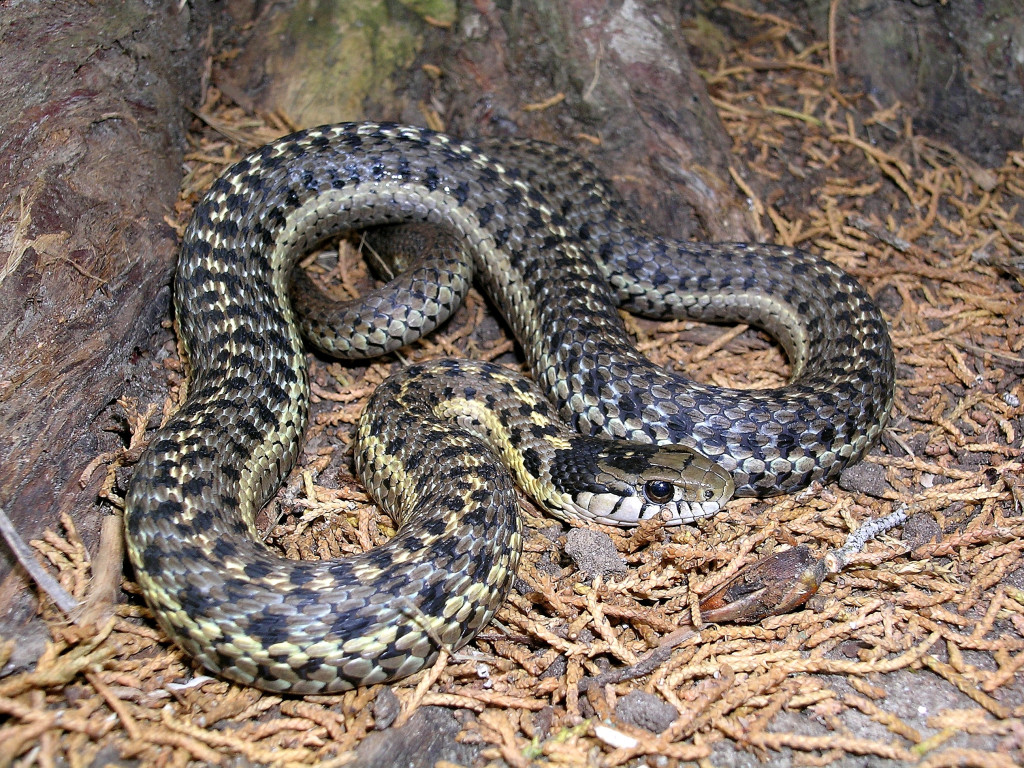
Western Ribbonsnake (Thamnophis proximus)
Although this snake doesn’t have “garter” in its name, they are still one of Nebraska’s four species of garter snakes. However, the name isn’t the only thing that’s unique about this species. The western ribbonsnake is the only garter snake in Nebraska that lacks vertical black bars on the lip scales around its mouth. However, like other species, they have keeled scales and are normally black to dark brown.
The mid-dorsal stripe that extends down its back is narrower than other species and is usually orange, and its belly is white with no markings. The lateral stripe for this species is as wide as the mid-dorsal stripe and is white and on scale rows 3 and 4. Overall, this snake is more slender than the other garter snakes, and its tail is much longer. The western ribbonsnake usually ranges 20-30 inches in length.
This species is semi-aquatic, and its preferred habitat is wet prairies, meadows and the edges of ponds and lakes where their main prey consists of amphibians, fish and even small lizards on occasion.
In the winter, this snake will even use crayfish and small mammal burrows for hibernation. It is not uncommon to see the western ribbonsnake emerge on warm days in February for a short time, but they will not truly emerge for the season until mid- to late March. Western ribbonsnakes in Nebraska are only known to be found in southeastern counties and are considered a species in need of conservation. They may only be collected with a permit.
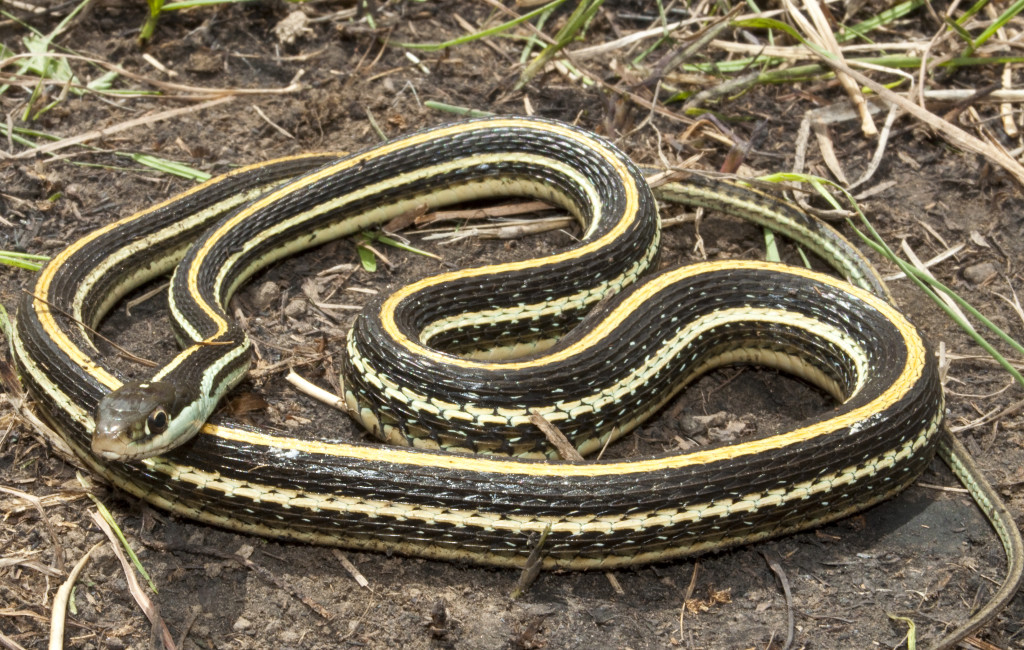
Plains Garter Snake (Thamnophis radix)
It is difficult to say exactly what a plains garter snake looks like as its color is extremely variable, even in Nebraska. Its ground color in western Nebraska is typically greenish, while on the eastern side of the state, the ground color is more red, especially around central Omaha. Like other garter snakes, they have keeled scales and a wide, bright yellow to orange mid-dorsal stripe down the length of its back. The plains garter snake also has two alternating rows of black spots bordering the stripe, which gives them their signature checkerboard look. In this species, the lateral stripes occur on scale rows 3 and 4 while the belly remains white and unmarked.
The plains garter snake can be differentiated from the western ribbonsnake by the appearance of black vertical bars on their labial scales from the mouth to the chin. These snakes average around 20-28 inches long, with adult females being significantly larger than the males.
The species can be found statewide across Nebraska in wet and moderately wet prairies with wetland associations in the form of streams, ponds or lakes, where they hunt for amphibians, fish, earthworms and slugs. They also are known to prey on hatchling ground nesting birds and small mammals, such as shrews and mice.
This garter snake normally emerges from hibernation later than other garter snake species, usually beginning its active season around April. Sightings of snakes basking in November is not uncommon, but most snakes have returned to their hibernation area around October. After emerging for the season, multiple males may court a single female to form a large breeding aggregation of snakes, sometimes known as a “mating ball” or a “ball of snakes.” Females give live birth to her young in mid- to late August.
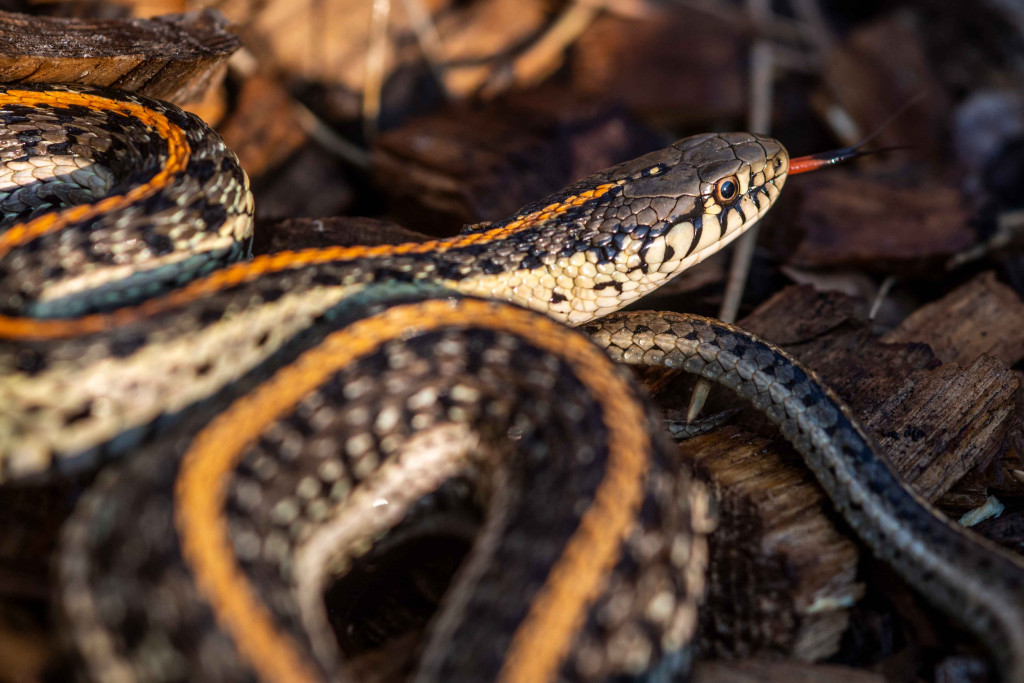
Common Garter Snake (Thamnophis sirtalis)
Like the plains garter snake, the common garter snake varies in color and pattern across its range. In Nebraska, they are commonly referred to as the “red-sided garter snake” and are often difficult to distinguish from the plains garter snake; you can differentiate the common garter snake by the red and black checkerboard pattern down the length of the body. Normally, this species is dark black or brown with a yellow mid-dorsal stripe and a pair of lateral stripes on scale rows 2 and 3.
This common garter snake averages 22-32 inches long and can be found in almost any habitat, from pristine stream sides and prairies, to woodlands, to suburban backyards. They are most commonly found in grassland-woodland edge habitats with permanent or temporary bodies of water, where they prey on fish, amphibians, earthworms and small mammals. This species can be found statewide in Nebraska.
The common gartersnake is known to be active every month of the year in Nebraska, but normally, it won’t emerge from winter hibernation until March. Like other garter snakes, multiple males will court and breed with a single female, which can result in multiple paternity. Up to 40 live young are born around late July or August. These snakes commonly enter winter hibernation around October, but they may come out on warm days in fall and winter to bask.
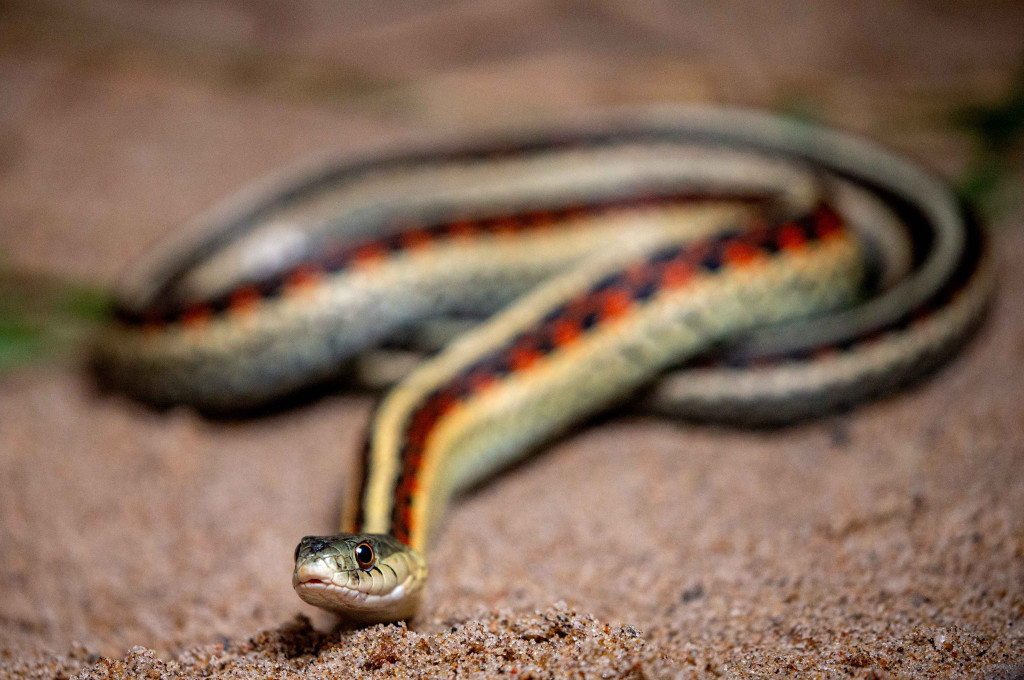
Garter Snakes Near Homes
Hopefully, you’ve learned a little bit more about garter snakes from this article. However, I understand that not everyone is thrilled to have these snakes around their homes, even if they are beneficial to the ecosystem. Here are a few tips to help reduce or eliminate garter snakes from your homes or structures.
Like other snakes in Nebraska, garter snakes are attracted to warm objects, which give them the heat they need for growth, digestion and reproduction. One may see garter snakes sunning themselves during the day and hiding at night. Retaining walls are often known to harbor large numbers of garter snakes, which can be removed or replaced with solid cement structures. Using rock or wood that fit tightly together will decrease the areas where snakes can find refuge. Trimming plants, shrubs and bushes and eliminating branches close to the ground can lessen the amount of available habitat as well.
Snakes do not have the ability to burrow into solid material. They are, however, able to squeeze into an opening as small as ¼ inch. Some of the most common entry points include garages, basement doors, foundation cracks, basement window frames, dryer vents and sump pump drain lines, so be sure to fill in gaps around utility lines, pipes and vents so there is nowhere for these snakes to enter. Place seals and barriers around windows and doors, and make sure garage doors are shut tightly as well.
Remember that garter snakes are beneficial and are completely harmless to you, your children and your pets. Snakes fear people and pets, and if left alone, they will typically do everything they can to avoid you.
To learn more about garter snakes and other snakes found in Nebraska, visit the reptiles of Nebraska page.
 Nebraskaland Magazine
Nebraskaland Magazine


